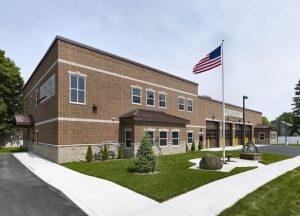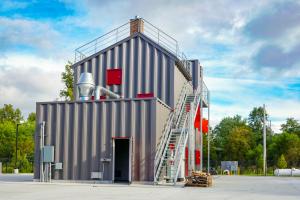Evolving Trends: Shaping Modern Municipal Fire Stations
The role of a firefighter has evolved significantly over the past 10 years. In addition to firefighting, first responders are now prepared for any disaster, medical response, or civilian disturbances, and they prioritize community service and public education on fire safety, which is often seen within local communities. However, while their responsibilities have broadened, the state of their stations, equipment, and technology has not kept pace. This issue is just one of the major trends impacting not only fire station architecture and design, but the industry as a whole. Below are several key fire station trends that are impacting municipalities and fire districts.
1. Utilizing Technical Precision – As communities expand and evolve with new land developments and shifting road networks, it is important for local leaders to consistently access the placement of their public safety and protection teams. Fire station site selection involves evaluating the location of public safety teams, employing Geographical Information Systems (GIS) for pinpointing ideal sites, assessing historical data, including response and drive times and hotspots, and establishing connections with community leaders for informed decision-making.
2. Rising Construction Costs – Today, fire station design necessitates strategic planning. Due to inflation and associated construction costs, budget cuts, and public pressure, municipalities are struggling to balance the urgent need to update fire stations with financial prudence. A modern fire station must accommodate a range of facilities with various spaces, from sleeping quarters, bathrooms, and shower rooms to training areas and decontamination centers. Each space, material, and decision must adhere to strict regulations, fire codes, and industry guidelines. Additionally, higher land acquisition costs and financing must be factored into construction costs to align municipal plans with community interests, ensuring informed decision-making about fire station size and space allocation.
3. Health and Safety – Many municipalities are incorporating modern design strategies not only in the materials used but also in building design and space planning relative to the health of the individuals who will be occupying the buildings. Our current fire station designs are thoughtful in the isolation of hazardous conditions and contaminants that may be harmful to the occupants. Much of the pre-planning goes into creating isolation zones between the apparatus bay and operational spaces within the building. Capturing contaminates traveling between spaces and around gear and equipment is a key focus in ensuring air quality. Pressurized vestibules are used between major spaces to capture and prevent infiltration of contaminated air from the apparatus bay into the main operational area. The main operational areas of the facility are designed to be comfortable for the building’s occupants, including living quarters, commercial kitchens, day rooms, and shower rooms, as well as more utilitarian spaces like locker rooms and offices. Implementing thoughtful design elements attracts employees and volunteers, reduces energy expenses, lowers water consumption, and creates a safe and healthy environment for occupants. Learn more about these improvements here.
4. Design Inclusivity – Fire station staffing has historically been made up of men. While nearly 95% of the US firefighting force is men, the number of women in the industry has increased to over 5%, encompassing both paid positions and volunteer roles. This shift towards gender inclusivity is reflected in the incorporation of private sleeping quarters alongside collaborative public spaces, demonstrating a commitment to fostering an inclusive and supportive environment for all members of the firefighting community. Acknowledging that fire stations operate around the clock, these spaces are evolving beyond mere public and residential areas, aiming to provide a comfortable home-away-from-home for staff. To learn more, click here.
5. Dedicated Training Facilities – The most effective emergency response teams engage in rigorous and ongoing training. However, considering that 70% of firefighters are volunteers, training is more than just a way to sharpen skills; it’s integral to the development and safety of these volunteers and our communities. Our facilities team designs integrated training aids within the stations to ensure ongoing high-quality training year-round. Bail-out windows, confined space entry, door intrusion, and mass confidence areas are just some of the systems and training aids we incorporate into stations. These areas and functions also serve as hubs for collaboration among neighboring departments and are instrumental in recruiting young, interested candidates. Some fire departments even establish centralized training campuses with specialized fire training structures to benefit multiple local departments. Learn more about the Rensselaer County Emergency Operations Training Facility here.
6. Co-Location – A growing trend in public safety involves the merging of fire services and law enforcement. Initially characterized by low-cost, high-labor operations, co-location is evolving in response to the increasing costs of public safety pay and benefits. This shift is particularly advantageous for smaller jurisdictions, as it offers a more sustainable model for running both fire and police services. By consolidating resources and expertise, co-location presents a promising solution for enhancing public safety and operational efficiency. This includes transitioning volunteer departments into combination or career-oriented ones.
7. Community Engagement – Modern fire departments are increasingly recognizing the pivotal role they play in their communities beyond emergency response. Updated fire stations are reinforcing their public connections by incorporating community rooms, complete with essential amenities such as a full kitchen, separate public restroom facilities, AV system, and seating arrangements for hosting community events. While emphasizing community education service and committing to safeguarding neighborhoods, fire departments are actively engaging in intentional outreach efforts. This includes educating the public about fire services sharing insights on design concepts, budget considerations, workforce diversity, and other crucial aspects. These initiatives collectively serve to foster support and appreciation for local fire stations, solidifying their integral role in the community’s well-being and safety.
The demand for modernizing fire stations resonates across communities nationwide, as municipalities seek to improve the design and functionality of these critical facilities. B&L recognizes these trends and is equipped to provide comprehensive technical services to any municipal project essential for fire station facility construction or renovation. Fire stations stand as pillars of public safety, housing essential personnel, firefighting apparatuses, protective gear, and specialized equipment that form the backbone of emergency response. Our experience in this market is solution-oriented, budget-minded, and designed to facilitate the smooth functioning of local government, safety, public access, and operational utilization. To learn more about how we can assist your community with the design or renovations of municipal facilities, please contact Timothy Bivens.





